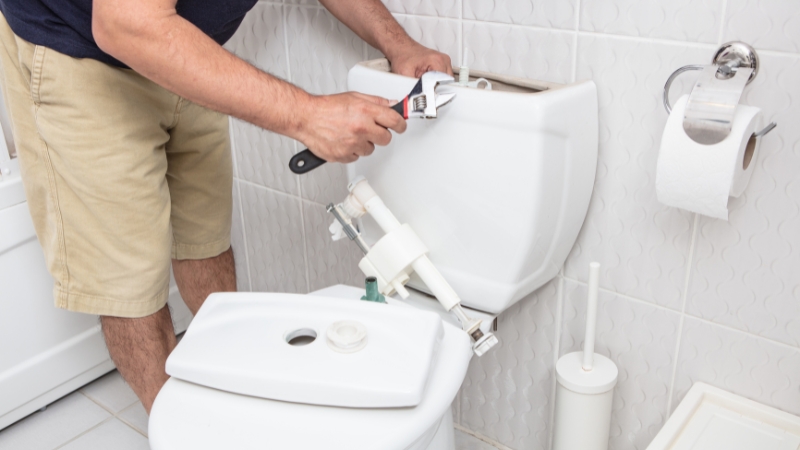Ever wondered why your toilet seems to never stop running? From worn-out flappers to faulty fill valves, a running toilet can be a real headache. In this post, we’ll dive into the common culprits behind this pesky problem and equip you with easy solutions to put an end to those constant waterworks. Ready to bid farewell to the sound of flushing money down the drain? Let’s unravel the mysteries of your running toilet together!
Table of Contents
ToggleUnderstanding the Function of a Toilet
Understanding Toilets’ Components
Toilets are essential plumbing fixtures that help efficiently remove waste. The key parts of a toilet include the bowl, tank, fill valve, flush valve, and flapper. When you flush a toilet, water flows into the tank through the fill valve before being released into the bowl via the flush valve.
To prevent toilet issues like running toilets or low toilet pressure, it’s crucial to understand how these components work together. The fill valve controls water entering the tank while the flush valve releases water from it into the bowl during flushing.
Common Causes of Running Toilets
- Worn Out Flapper: A deteriorated flapper can cause continuous water leakage from the tank to the bowl.
- Faulty Fill Valve: If your fill valve isn’t working correctly, it may lead to constant refilling of your toilet tank.
- Improper Chain Tension: An improperly adjusted chain connecting the flapper to its handle can result in a running toilet.
Identifying these common issues is vital in fixing a running toilet effectively. For instance, if you notice constant trickling sounds coming from your toilet even when not in use, there might be an issue with either your flapper or fill valve that needs attention.
Tips for Fixing Running Toilets
- Begin by inspecting both the flapper and fill valve for any signs of wear or damage.
- Adjust or replace any worn-out components accordingly to ensure proper functioning.
- Check and adjust chain tension between the flapper and handle as needed for smooth operation.
Common Causes of a Running Toilet
Faulty Flapper
A running toilet can be irritating, especially when it’s due to a faulty flapper. The flapper is responsible for sealing the flush valve opening. If it doesn’t seal properly after flushing, water will continuously leak into the bowl. This constant flow triggers the toilet to run persistently.
The fill valve in your toilet tank controls the water level after each flush. When this mechanism malfunctions, an imbalanced float height or incorrect water level occurs, leading to a running toilet situation. As a result, water keeps flowing into the overflow tube without stopping.
Malfunctioning Fill Valve and Loose Flush Valve Chain
Another common cause of a running toilet is a malfunctioning fill valve or a loose flush valve chain. The fill valve refills the tank with water after flushing and stops once the appropriate level is reached. If this part fails to function correctly, it may lead to continuous running as excess water flows into the tank non-stop.
Diagnosing a Running Toilet Issue
Constant Water Flow into Overflow Tube
A running toilet can be identified by checking if water is continuously flowing into the overflow tube. This issue occurs when the fill valve fails to shut off, leading to excess water entering the tank and causing it to overflow. The constant flow of water not only wastes water but also increases your utility bills unnecessarily.
Pros
- Easy identification method
- Helps prevent water wastage
Cons
- May require replacement parts
- Can lead to high water bills if left unfixed
Hissing Sounds and Bowl Movement
Another way to diagnose a running toilet is by listening for hissing sounds or observing continuous movement in the toilet bowl after flushing. These signs indicate that there might be a leak in the tank or an issue with the flush valve, allowing water to escape constantly. Addressing this problem promptly can save you from potential damage and higher expenses.
Key Information
- Hissing sounds suggest internal leakage.
- Continuous bowl movement indicates an ongoing issue.
List of Examples:
- Imagine hearing a faint hissing sound even when no one has used the toilet recently.
- Picture seeing ripples in the bowl as though someone just flushed it, without anyone actually doing so.
Dye Test with Food Coloring
Conducting a dye test using food coloring is another effective method to determine if your toilet is running. By adding food coloring directly into the tank, you can easily detect any leaks from the tank into the bowl. If colored water appears in the bowl without flushing, it confirms that there’s indeed a running toilet issue that needs immediate attention.
- Add several drops of food coloring into your toilet tank after removing its lid.
- Wait for about 10-15 minutes without flushing.
- Check if colored water starts appearing in your toilet bowl; this indicates a leak.
Adjusting the Float Height and Water Level
Locating the Float Mechanism
To address running toilet woes, start by finding the float mechanism in the tank. It’s usually a ball or cup attached to an arm. Adjust this mechanism to control how much water enters the tank after a flush. If it’s set too high, water may continuously flow into the overflow tube, causing constant running.
When you’ve located the float mechanism, ensure it is not positioned excessively high or low. A float set too high will lead to water overflowing into the overflow pipe, resulting in continuous running. Conversely, if it’s too low, insufficient water will fill up after flushing.
Testing and Confirming Adjustment
After adjusting the float height to achieve optimal settings for your toilet, test its functionality by flushing. Observe whether sufficient water fills up without overflowing when flushed. The correct adjustment should stop additional filling once reaching an appropriate level post-flush.
- Locate float mechanism
- Avoid setting float too high or low
- Test adjusted height by flushing
Fixing or Replacing a Faulty Flapper
Inspect Flapper for Signs of Wear
When dealing with running toilet woes, it’s crucial to examine the toilet flapper for wear, damage, or misalignment. These issues can lead to leaks and continuous water flow. If you notice any problems with the flapper, it might be time for a replacement.
A worn-out flapper can cause water wastage and lead to higher bills. To prevent this, look for signs of damage such as cracks or warping in the rubber material. Even a slight misalignment can disrupt the sealing process and result in a running toilet.
Clean or Replace Ineffective Flappers
If your inspection reveals that the flapper is not sealing properly, causing water to flow into the bowl continuously, cleaning may help temporarily but replacing is often necessary. Sometimes debris build-up prevents proper closure. A simple switch could solve this issue effectively.
Replacing an ineffective flapper is relatively easy and cost-effective compared to hiring professional help every time your toilet runs continuously. By doing this simple fix yourself, you save time and money while ensuring your toilet functions efficiently.
Pros:
- Cost-effective solution
- Easy DIY repair
Cons:
- Requires periodic maintenance
Troubleshooting the Fill Valve and Flush Valve Chain
Checking the Fill Valve
To address running toilet woes, start by examining the fill valve for any issues. Look for clogs, debris, or malfunctions that might hinder it from shutting off properly. A faulty fill valve can lead to continuous water flow into the toilet bowl, causing a running toilet. If you notice any blockages or irregularities in the fill valve, clean them out thoroughly.
A malfunctioning fill valve is a common cause of a running toilet. By checking for clogs and debris regularly, you can prevent this issue from occurring frequently. Ensuring that your fill valve operates smoothly is crucial to maintaining an efficiently functioning toilet.
Adjusting the Flush Valve Chain
Another essential step in troubleshooting running toilet problems involves adjusting the flush valve chain’s length correctly. The chain should have enough slack to allow the flapper to seal tightly after flushing but not so much that it gets tangled or caught under other components inside the tank.
Proper adjustment of the flush valve chain prevents unnecessary leaks and ensures that water stops flowing once the tank is full after flushing. This simple maintenance task can significantly impact your toilet’s performance and help eliminate running water issues effectively.
Clearing Blockages and Adjusting the Overflow Tube
Clearing Blockages
To tackle a running toilet due to blockages, grab a plunger or a toilet auger. Plunge the drain vigorously to dislodge any clogs obstructing the water flow. The force created helps push through and remove debris causing the blockage.
Pros:
- Effectively clears out clogs.
- Simple tools can be used.
Cons:
- May require multiple attempts.
Sometimes, more stubborn clogs may need an auger to break them up effectively. Insert it into the drain and rotate it gently but firmly until you feel resistance fading away. This method is particularly useful for harder obstructions that plungers might not fully clear.
Adjusting the Overflow Tube
Another common cause of a running toilet is an improperly set overflow tube height. To address this issue, locate the overflow tube inside your tank; typically, it’s in the middle of your tank connected to the fill valve assembly. By adjusting its height using channel locks or other suitable tools, you can control water levels within your tank better.
Steps for Adjustment:
- Identify where adjustment needs to be made.
- Loosen any clips holding the tube in place.
- Carefully adjust its height as needed.
If water continuously flows into this tube without stopping or if it’s submerged underwater constantly, adjustments are necessary to prevent continuous flushing issues from occurring.
Remember that keeping an eye on these components regularly can help prevent future running toilet woes by addressing potential problems before they escalate further.
When to Seek Professional Plumbing Help
Signs of Complex Issues
If your attempts at DIY troubleshooting for a running toilet have hit a dead-end, it might be time to reach out to a professional plumber. Persistent running toilets could signal more intricate problems within the toilet’s internal mechanisms. While you may have successfully cleared blockages or adjusted the overflow tube, continuous running suggests deeper issues that require specialized attention.
When simple fixes like adjusting the flapper or float mechanism fail to stop your toilet from running incessantly, this is a strong indicator that you need professional plumbing help. A skilled plumber has the expertise to diagnose and rectify any underlying complications causing your toilet woes. By seeking professional assistance, you can ensure that all aspects of your toilet’s functionality are thoroughly inspected and repaired accurately.
Benefits of Hiring a Plumber
Engaging a plumber when faced with persistent running toilet problems offers several advantages. Professional plumbers possess comprehensive knowledge and experience in dealing with various plumbing issues, ensuring an accurate diagnosis and effective resolution of complex problems. Their expertise allows them to identify hidden causes behind continuous running toilets that DIY methods might overlook.
- Expert Diagnosis: Plumbers can pinpoint specific faults in your toilet’s components that contribute to its continuous operation.
- Efficient Repairs: Professionals efficiently fix complex issues with precision, preventing further damage and ensuring long-term functionality.
- Peace of Mind: Hiring a plumber provides reassurance that all underlying concerns causing your running toilet will be addressed effectively.
Maintaining Your Toilet to Prevent Future Issues
Regular Maintenance Checks
To prevent running toilet woes, it’s crucial to conduct regular maintenance checks on key components like the flapper, fill valve, and flush valve chain. Inspect these parts for any debris buildup that could hinder their proper functioning. By keeping them clean and free from obstructions, you can avoid common issues such as running toilets or incomplete flushing cycles. A simple visual inspection every few months can help you catch potential problems early on.
Regularly cleaning these components is essential in maintaining a properly functioning toilet. The flapper, fill valve, and flush valve chain are susceptible to wear and tear over time due to constant use. Ensuring they are debris-free will prolong their lifespan and prevent unnecessary malfunctions that may lead to running toilets or water wastage.
Preventing Clogs
Another critical aspect of maintaining your toilet is preventing clogs by being mindful of what goes down the drain. Avoid flushing excessive amounts of toilet paper or foreign objects down the toilet as they can easily cause blockages in the pipes. Toilets are designed to handle specific materials, so it’s important not to overload them with items that could potentially damage the plumbing system.
Preventative measures go a long way in avoiding running toilet issues caused by clogs. By educating household members about proper disposal practices and ensuring only suitable items are flushed down the toilet, you can significantly reduce the risk of blockages occurring within your plumbing system. Implementing these simple habits can save you from dealing with costly repairs in the future.
Conclusion
You’ve now mastered the art of troubleshooting a running toilet! By understanding how your toilet works and tackling common issues like adjusting the float height, fixing the flapper, and clearing blockages, you’re equipped to handle most problems that come your way. Remember, regular maintenance is key to preventing future headaches with your toilet. Stay proactive in keeping it in top shape!
Don’t let a running toilet dampen your day—take charge and fix it yourself! With these simple steps and a bit of know-how, you can save time and money on plumbing repairs. Keep your toilet running smoothly and efficiently by staying on top of maintenance tasks. Happy fixing!
Discover the Premier Solution for Running Toilets with Garcia Home Restoration!
At Garcia Home Restoration, we recognize the annoyance and waste caused by running toilets in your household. Our team, acclaimed for its proficiency in running toilet diagnosis and repair, is committed to resolving this common yet challenging issue, ensuring your home’s plumbing operates efficiently.
Our commitment at Garcia Home Restoration goes beyond mere fixes; we strive to enhance the overall functionality and conservation in your home. We have solidified a remarkable reputation in Contra Costa County for our dedication to quality, our comprehensive understanding of plumbing issues, and the trust we’ve established with numerous satisfied customers. Don’t let a running toilet escalate your water bills or disrupt your daily life. Contact us today for top-tier running toilet repair services and enjoy the comfort and assurance of a flawlessly functioning bathroom!




